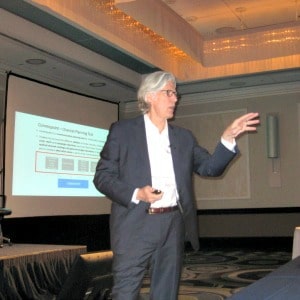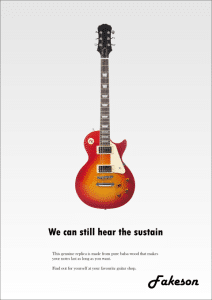
(by Bob McCurdy)
Simon and Garfunkel were on to something when they wrote The Sound of Silence. Maybe we can learn something from them and their #1 hit. A couple of seconds of “silence” strategically placed within a Radio commercial could greatly enhance the effectiveness of the remaining 27 seconds. Where is it written that every second of every Radio commercial needs to contain a voice, music or SFX. We believe that silence could be the ultimate engagement tactic.
A considerable portion of that “75%”, is based on a commercial’s ability to get the listener to engage. Minimum engagement leads to minimum impact. The digital guys have their annoying rollovers and takeovers to highjack our attention but what if we were able to get the Radio listener to engage with Radio creative in a less annoying and subtle fashion?
It’s been often said if you want more engagement, create a more engaging commercial. We have an idea how.
“Engagement” has been an advertising buzz word for the past decade. In 2006 the Association of National Advertisers (ANA), the American Advertising Association of American (4A’s) and the Advertising Research Foundation (ARF) came together and defined engagement as: “Turning on a prospect to a brand idea enhanced by the surrounding context.” A turned-on customer results from stimulating co-creation, which leads to a more personal, deeper brand meaning.
A couple of thoughts about that definition.
First, we think they probably could have come up with a better one.
Second, we always liked their inclusion of the word “co-creation”, as we believe that it is a key strength of radio, in that a Radio commercial lays out “a scenario” and the listener has got to fill in the blanks based upon their own personal experiences. This is why Radio was the first “addressable medium”.
Third, the wording “surrounding context” is key and got us thinking a while back that maybe we can take a page out of print’s book (no pun intended) to enhance engagement with Radio commercials.
One effective tactic that print “creatives” use in print ads to engage the reader is the use of what’s referred to as “white space”. “White space” is defined as all the space on the page minus the words and pictures. BTW, it doesn’t have to be “white”.
Why would an advertiser purposely choose to not use every square inch of ad space they paid for? One simple reason, they want the ad to be as effective as possible and their key messaging to stand out, grabbing the reader’s eyes.
So why would a retailer or copywriter buy into the concept of “white space” in print, yet when it comes to Radio, create copy whose goal often appears to be to fit the most amount of words humanly possible into thirty or sixty seconds? Possibly because we hadn’t broached and coached them on the concept of “audio white space”.
The ad below is a good example of the effective use of “white space” in print (“white space” is also used in digital ads as well) and it’s easy to see why it remains an important design element for several reasons:
-It separates elements on a page making it easy to read. If something is difficult to read, it would likely not be read.
-It creates focus and enables key messaging to stand out, i.e. effectively communicating the key selling proposition- it grabs the eyes, it pops.
Compare the ad above with the ad below, which is often the print equivalent of a Radio ad where even the kitchen sink is usually thrown in. Which ad is more effective?
“White space” is all about “contrast”. So how do we create “audio white space” and “contrast” that grabs our ears? By generating something that is known in the world of psychology as an “orienting response” (OR).
An “OR” is defined as an automatic and involuntary allocation of our attention to something novel or surprising in our environment. It is called an orienting response because our senses automatically focus/orient on the source of the stimulus. We hear a loud noise, we turn our heads. We hear a scream, we turn our heads. There’s suddenly silence where previously there was sound, we begin to listen intently, trying to ascertain, “what’s up?’. This “OR” response enabled our ancestors to beat it when they sensed a sabre toothed tiger was around.
We’ve all experience an “OR” while listening to the Radio even in a distracted, “hearing” mode, when suddenly the station experiences technical difficulties and goes silent or the jock is a second or two late in cueing the next record or the network newsfeed is a second or two late. This unexpected silence immediately grabs our ears attracting our attention. The reason? “Contrast”.
“Contrast” is defined as a “striking exhibition of unlikeness”. What’s most strikingly unlike anything that comes out of a radio speaker? Silence. The sudden absence of sound commands our attention every bit as much as a loud bang or scream. Could this absence of sound be strategically deployed within a commercial to grab our ears and enhance engagement? Absolutely.
We’ve all heard of the term “pregnant pause”, which is defined as “a pause that gives the impression it will be followed by something “significant”. This pause hijacks our ears even if we were not paying attention. Think back to a meeting where the speaker droning on and then there’s silence or when you were in school and the teacher is droning on and then silence. You experience a “what is it” response, a “something’s in my environment is different and I better pay attention” self-preservation response.
Silence when “contrasted” with noise commands our attention as powerfully as noise commands our attention when “contrasted” with silence.
How do we put this stuff to work in Radio creative? What about utilizing a slight pause at the beginning of a commercial to grab the listener’s attention and to separate our message from the previous commercial or a pause at the end of a commercial providing the listener with a second or two to absorb our messaging before being immediately bombarded with another one?
This concept is nothing new. Many of the great classical composers, Beethoven, Schubert, Mozart, etc. understood the importance of a pause between their symphonic movements, providing the listener with a brief respite to absorb and appreciate what they just heard before seguing into the next one.
We often use pregnant pauses effectively in daily conversations with our kids and during our presentations to command attention. Why not use this tactic in Radio creative?
At an absolute minimum, a strategic pause at the beginning, middle or end of a commercial or the tactical use of silence (“contrast”) enables the audience to more effectively process and retain what they just heard and anything that can be done to enhance the processing of a commercial message is a good thing.
So instead of an advertiser filling thirty or sixty seconds with as many words spoken at the rate of the world’s finest auctioneer , maybe they slow it down an bit and allocate 2-3 seconds to strategic pauses that will serve to enhance the engagement and subsequent effectiveness of their commercial. The Guitar advertiser above only utilized 10%-15% of their purchased space and we’d bet they we quite pleased with their results.
Allocating two or three seconds out of a thirty second commercial to the strategic use of a pregnant pause or silence could have a geometrically positive impact on the remaining twenty-six or twenty-seven seconds of copy!
One final thought re Radio creative: Perfection is achieved not when there is nothing left to add, but when there is nothing left to take away.
Take a minute to click on the article below even if your market is not a PPM market. Nielsen recently made improvements in their PPM device enhancing the Critical Band Encoding Technology which is able to detect with greater precision actual Radio listenership thus narrowing the listenership gap between the diary and PPM.
The results are a +13% increase in total 6+ listening and 10%+ increases in 25-54’s and 18-34’s.
If you are in a PPM market this could enable you to justify a rate increase particularly by doing a reverse CPM computation and even if you are not, this is great news for the entire Radio industry. Radio, in addition to being the #1 reach medium in the country has 10%-13% more listeners tuned in at any given time than previously reported, again confirming just how deeply Radio is entrenched in people’s lives.
Audio’s Growing Ratings and Enhance Encoding.
Bob McCurdy can be reached at [email protected]. Visit his website www.wenarrowthegap.com








Great article… lots to consider here.
I was recently have a similar discussion with regard to programming… the need to step away from the fear of “dead air” and instead, allowing (a reasonable) pause… giving a moment for an idea to land. Perhaps with music.. perhaps not… but an intention moment, that allows the listener to take it in.
I was thinking about “pregnant pause” as a space where something new can be born. You have furthered my understanding of that, by suggesting that what might be born, is engagement. Cool.
What a terrific article. My compliments to RadioInk. Nothing like opinions backed up by specifics and facts.
The man is an infidel and a heretic.
Get me a rope! 🙂